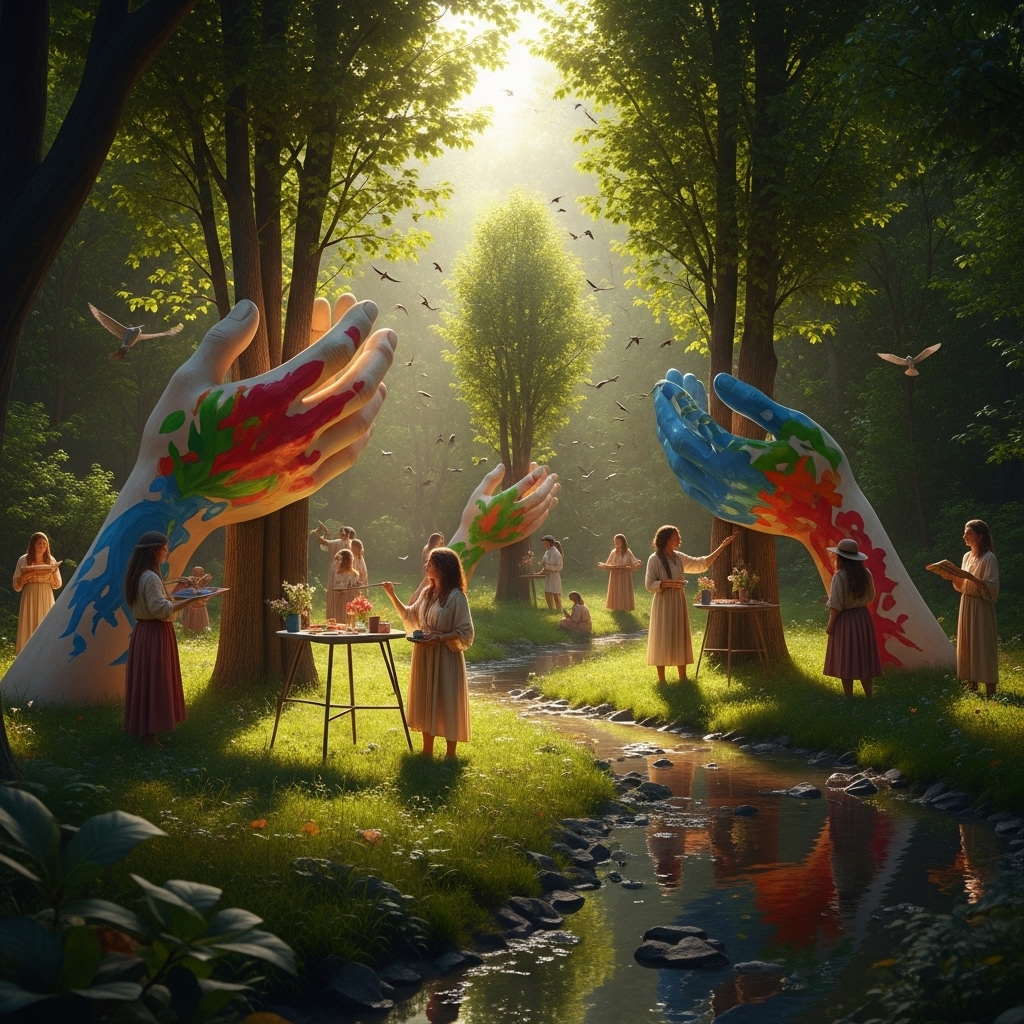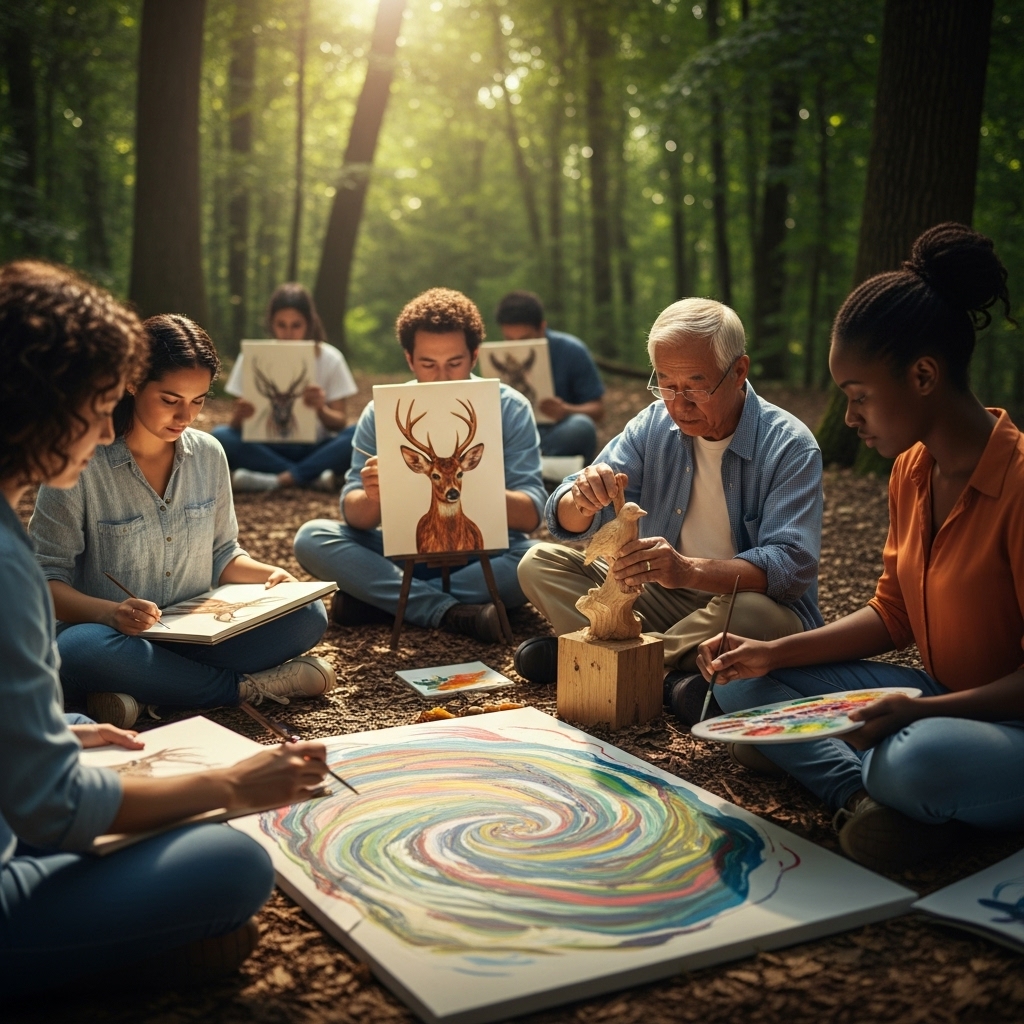In a world increasingly filled with technology, the profound connection between humanity and nature often feels overshadowed. However, powerful art emerges as a beacon, illuminating our intertwined roles and celebrating the beauty of this relationship.
Exploring the Essence of Human-Nature Connection Through Art

As I delve into the world of art that celebrates our connection to nature, I find myself drawn to the myriad ways artists express this intricate relationship. Every brushstroke, every sculpture, and every installation serves as a reminder of our place within the natural world. The beauty of art lies not just in its aesthetic appeal, but also in its ability to evoke emotions and provoke thoughts. I’ve often marveled at how art encapsulates feelings that words sometimes cannot convey. The act of creating and appreciating art becomes a contemplative journey, one that invites us to reconnect with the environment that sustains us.
The Power of Nature as a Muse
Nature has always been a powerful muse for artists across the centuries. From the vibrant landscapes of the Romantic era to the abstract interpretations of modern art, nature’s influence is undeniable. I often think about how artists like Claude Monet captured fleeting moments of light and color in his water lilies, evoking a sense of tranquility and a deep appreciation for the natural world. When I look at his paintings, I can almost hear the gentle rustle of leaves and feel the cool breeze on my skin. It’s a sensory experience that transcends time and space.
Furthermore, I’ve discovered that artists often utilize their work to comment on environmental issues, highlighting the delicate balance we must maintain with our planet. The art of Andy Goldsworthy, for example, showcases nature’s beauty while also drawing attention to its fragility. His ephemeral installations made from leaves, stones, and ice remind me that beauty is often temporary and that we must cherish and protect our environment. This duality of nature as both a source of inspiration and a canvas for reflection resonates deeply with me.
Art as a Medium for Connection
As I explore different art forms, I find that many contemporary artists are using their platforms to foster a deeper connection between people and the natural world. For instance, installations that invite viewer participation create a unique bond between the observer and the artwork. I recall visiting a large-scale installation by Olafur Eliasson, where sunlight filtered through a myriad of colored glass panels, casting vibrant hues throughout the space. The experience felt immersive, almost as if I were stepping into a living painting. This interaction reminded me of my own connection to light and color in nature, reinforcing the idea that our surroundings are not just backdrops but active participants in our lives.
Moreover, I have noticed how public art projects often inspire communities to engage with their local environments. Murals that depict local flora and fauna serve not only as beautification efforts but also as educational tools. They provoke discussions about local ecosystems and encourage conservation efforts. One project that particularly struck me was an initiative to paint murals featuring endangered species in urban areas, blending artistry with activism. This approach resonates with my belief that art can drive change and inspire action, reminding us of our collective responsibility towards nature.
The Role of Technology in Art and Nature
Interestingly, technology has also begun to play a significant role in how artists convey the human-nature connection. Digital art and multimedia installations open up new avenues for exploration and expression. I think about how virtual reality experiences allow people to immerse themselves in natural environments, creating a visceral understanding of distant ecosystems. This blend of technology and nature can foster empathy, as individuals experience places they may never visit in real life.
However, I also find myself reflecting on the potential pitfalls of this technological integration. While digital art can create awareness, I wonder if it ever detracts from the raw, tangible beauty of nature. There’s something irreplaceable about experiencing art in its physical form, where the textures and materials speak to me in ways that pixels on a screen cannot. Balancing the benefits of technology with a grounding in the natural world is a challenge that both artists and audiences must navigate.
Conclusion: An Ongoing Dialogue
As I consider the diverse expressions of our connection to nature through art, I realize that this dialogue is ongoing. Every work of art has the potential to spark curiosity, provoke thought, and foster a greater appreciation for the world around us. In my journey through this exploration, I’ve come to understand that art is not just a reflection of life but a means to deepen our connection to it. It serves as a bridge between humanity and nature, reminding us of our shared existence and the beauty that lies in our interdependence.
The Healing Power of Nature in Art

Throughout my exploration of art, I’ve come to appreciate the transformative power of nature, not just as a backdrop for artistic expression but as a healer in itself. Nature has an innate ability to soothe the soul, and artists have long tapped into this essence to create works that inspire wellness and reflection. I often find myself drawn to pieces that evoke a sense of calm, a reminder of the peace that can be found in nature’s embrace.
Consider the art of landscape photography, where artists like Ansel Adams have captured the raw beauty of wilderness in a way that invites viewers to breathe deeply and savor the serenity of natural vistas. His black-and-white images of Yosemite National Park resonate within me, stirring a longing for the mountains, the trees, and the quiet whispers of the wind. It’s as if each photograph serves as a portal to a place where stress dissipates, and clarity emerges. When I gaze at such photographs, I can almost feel the cool mountain air filling my lungs, a visceral connection that transcends the frame.
Additionally, I think about installation art that seeks to create immersive environments, embodying the restorative qualities of nature. For instance, I remember stepping into a space designed by artist Yayoi Kusama, where mirrored surfaces and light created an illusion of infinity adorned with flowers. The experience felt like being enveloped in a garden, an escape from the buzzing world outside. This sensation of tranquility is something I crave, and it highlights the healing potential of art that draws inspiration from the natural world.
Art as a Catalyst for Environmental Awareness
In my journey, I’ve been inspired by artists who use their work to promote environmental awareness and activism. These creators challenge us to confront our relationship with the environment, urging us to take action. For instance, the work of Olafur Eliasson extends beyond mere visual appeal; his projects often engage communities in discussions about climate change and sustainability. I recall a particular installation where he used glacial ice to create a melting sculpture, forcing viewers to confront the realities of climate change. This raw, tangible representation of environmental degradation left a lasting impression on me, emphasizing that art can ignite passion and provoke change.
Moreover, I’ve discovered the power of participatory art projects that involve communities in environmental stewardship. One such initiative that resonated with me involved local artists and residents collaborating to create art from recycled materials. This endeavor not only beautified public spaces but also fostered a sense of ownership and pride in the environment. It was heartening to see how creativity could mobilize individuals to take responsibility for their surroundings, reminding me that art is a powerful vehicle for social change.
The Intersection of Science and Art
Another fascinating facet of this exploration is the intersection of science and art, particularly in how artists convey complex environmental issues. I’ve come across artists who collaborate with scientists to visualize data related to climate change, biodiversity, and ecological health. These collaborations often result in stunning visual representations that make scientific concepts accessible and engaging. I think about pieces that transform statistics into vibrant, colorful works of art, drawing attention to issues that might otherwise go unnoticed. This fusion of disciplines highlights the importance of interdisciplinary approaches to understanding and addressing the challenges we face.
For example, I remember an installation that utilized projections to illustrate the effects of rising sea levels on coastal communities. The visual impact was profound, making the abstract data feel immediate and personal. It’s experiences like these that demonstrate how art can serve as a bridge, translating scientific findings into impactful narratives that resonate with a wider audience.
Personal Reflections and Artistic Inspiration
As I reflect on my own creative journey, I find that my connection to nature deeply influences my artistic endeavors. Whether it’s through writing, painting, or photography, the natural world serves as a constant source of inspiration. I often venture outdoors, allowing the sights and sounds of nature to fill my senses. The rustling of leaves, the vibrant colors of a sunset, and the intricate patterns of flowers all fuel my creativity and remind me of the beauty surrounding us.
In those moments of inspiration, I feel a sense of responsibility to share my experiences through art. I strive to create pieces that not only capture the essence of nature but also evoke emotions and provoke thoughts about our relationship with the environment. Whether I’m penning a poem that celebrates the changing seasons or crafting a painting that reflects the tranquility of a forest, my goal is to inspire others to reconnect with the natural world.
Final Thoughts
Through my exploration of art and its profound connection to nature, I’ve come to appreciate the myriad ways in which creativity can illuminate our shared existence. Each piece of art tells a story, evokes an emotion, and serves as a reminder of our interdependence with the environment. As I continue this journey, I remain hopeful that art will continue to inspire greater awareness, foster connections, and ultimately drive us toward a more harmonious relationship with the natural world.
Every brushstroke, every installation, and every performance carries the potential to make a difference. It is in this ongoing dialogue between humanity and nature that I find my purpose as both an artist and a passionate advocate for the environment.
